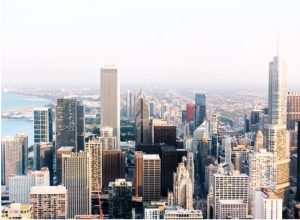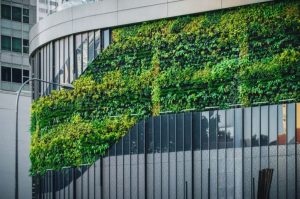The “urban heat island effect” is a phenomenon that affects cities all around the world. It refers to the way cities trap heat, making their temperatures warmer than the surrounding areas. The city then becomes an “urban heat island.” The Environmental Protection Agency estimates that, compared to its surroundings, a city of 1 million people could be anywhere from 1.8-5.4 degrees Fahrenheit (1-3 degrees Celsius) warmer due to this effect (National Geographic).

Urban heat islands generally have higher energy costs for things like air conditioning as people try to combat the rising temperatures. With climate change, the effects of urban heat islands could increase drastically over the course of the century, especially for lower-income communities (EPA).
The causes for urban heat islands can be traced back to a few key factors. The materials used to build cities, such as concrete and asphalt, contribute to urban heat islands the most since they trap heat better than vegetation does. Therefore, an environment with more of these materials is naturally going to be warmer as it traps the heat from the sun (EPA).

Another cause for urban heat islands is “waste heat;” a term that refers to the heat generated by energy from various sources. Cars burn off energy while in use, as do factories, tools, etc (National Geographic).
Climate scientists from NASA’s Goddard Institute for Space Studies (GISS) are now considering several options for combatting the urban heat island effect. One suggestion is the implementation of “green roofs” across cities. Green roofs are roofs covered in soil and living vegetation (ScienceDaily). These roofs are not only able to reduce heat in an urban setting, but they also absorb pollutants in the air, thereby improving air quality. Several cities even provide financial incentives in the form of tax credits to businesses who install green roofs on their buildings (EPA).
In several tests, GISS was able to demonstrate the effectiveness of green roofs by implementing them at various sites in Chicago. In experiments where green roofs were installed on top of existing buildings, they were able to measure a substantial decrease in temperature in comparison to the change in temperature at a control site (ScienceDaily).

In addition to green roofs, other solutions include increased vegetation on the ground. Planting trees and bushes around a city will generate greater cooling effects for the population (EPA).
With the implementation of green roofs combined with greater levels of vegetation in urban areas, scientists hope to combat the effects of rising temperatures in cities which will create a healthier environment for those living there.
Written by: Matthew Jenkins
Date: May 7th, 2022
https://www.epa.gov/green-infrastructure/reduce-urban-heat-island-effect
https://www.sciencedaily.com/releases/2022/03/220321150421.htm
https://www.nationalgeographic.org/encyclopedia/urban-heat-island/
